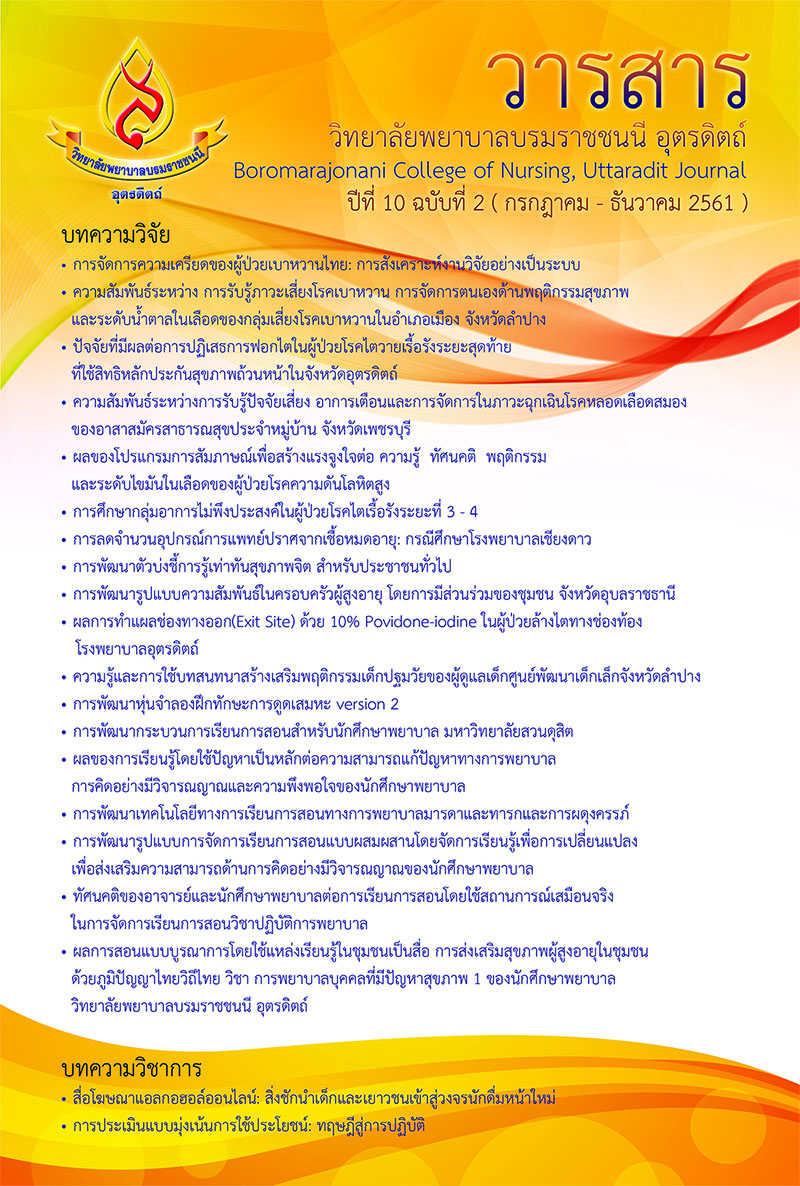การลดจำนวนอุปกรณ์การแพทย์ปราศจากเชื้อหมดอายุ: กรณีศึกษาโรงพยาบาลเชียงดาว
Main Article Content
บทคัดย่อ
การวิจัยเชิงพรรณนานี้มีวัตถุประสงค์เพื่อลดจำนวนอุปกรณ์ปราศจากเชื้อหมดอายุการใช้งานในโรงพยาบาลเชียงดาว การวิจัยใช้แนวทางการดำเนินกิจกรรมกลุ่มคุณภาพโดยใช้เครื่องมือพื้นฐานในการปรับปรุงงาน เช่น เครื่องมือคุณภาพ 7 ชนิด เครื่องมือที่ใช้เป็นใบเก็บข้อมูล วิเคราะห์ข้อมูลโดยใช้ความถี่และร้อยละ และข้อมูลเชิงคุณภาพโดยใช้การจัดหมวดหมู่ ผลการศึกษาพบว่าสามารถลดจำนวนอุปกรณ์ปราศจากเชื้อหมดอายุได้อย่างต่อเนื่องจากเฉลี่ย 405 ชิ้นต่อเดือน เหลือเพียงเฉลี่ย 131 ชิ้นต่อเดือน และเหลือเพียง 46 ชิ้น ในเดือนสุดท้ายก่อนจบโครงการ โดยไม่มีผลกระทบต่อการขาดอุปกรณ์ปราศจากเชื้อในการให้บริการ
Article Details
บทความหรือข้อคิดเห็นใดใดที่ปรากฏในวารสารวิจัยการพยาบาลและวิทยาศาสตร์สุขภาพ เป็นวรรณกรรมของผู้เขียน ซึ่งบรรณาธิการหรือสมาคมศิษย์เก่า ไม่จำเป็นต้องเห็นด้วย และบทความที่ได้รับการตีพิมพ์เผยแพร่ถือเป็นลิขสิทธิ์ของวารสารวิจัยการพยาบาลและวิทยาศาสตร์สุขภาพ
เอกสารอ้างอิง
2. Bamford, D.R. & Greatbanks, R.W. (2005). The use of quality management tools and techniques: A study of application in everyday situations. International Journal of Quality & Reliability Management, 22 (4), 376-392.
3. Boonchaisri, P., Lertwatthanawilat, W. & Unahalekhaka A. (2017). Reuse of single-use medical devices in secondary and tertiary hospitals. Internals and Journal of Evidence Evidence -Based Healthcare,14, S15. doi:10.1097/01.XEB.0000511637.43808.of
4. Canel, C. & Kadipasaoglu, S. (2002). Quality control circles in the Veterans administration hospital. International Journal of Health Care Quality Assurance, 15 (6), 238-248
5. Chaiprasit, S., Kulophas, D. & Siribanpitak, P. (2016). Management strategies for enhancing high performance organization of nursing colleges under the Ministry of Public Health. Boromarajonani College of Nursing, Uttaradit Journal, 8(2), 112-130. (in Thai)
6. Ishikawa, K. (1976). Guide to Quality Control. Asian Productivity Organization. Tokyo.
7. Jacobs, P., Polisena, J., Hailey, D., & Laffty, S. (2008). Economic analysis of reprocessing single-use medical devices: A systematic literature review. Infection Control and Hospital Epidemiology, 29 (4), 297-301.
8. Nuchphong, C., Wongkhomthong, S., Wongkhomthong, J. & Sritoomma N. (2017). The hospital financial strategy of chief financial officers in community hospitals under the Ministry of Public Health. Boromarajonani College of Nursing, Uttaradit Journal, 9(1), 23-33. (in Thai)
9. Salaheldin, S.I. & Zain, M. (2007). How quality-control circles enhance work safety: a case study. The TQM Magazine, 19 (3), 229-244.
10. Tennant, C., Warwood, S.J. & Chiang, M.M.P. (2002). A continuous improvement process at Seven Trent Water. The TQM Magazine,14(5), 248-292
11. Tessarolo, F., Caola, I. & Nollo, G. (2011). Critical issues in reprocessing single-use medical devices for interventional cardiology. Biomedical Engineering, Trends, Research and Technologies, 619-644. doi: 10.5772/13582
12. Trehan, M. & Kapoor, V. (2011). TQM journey of an Indian milk-producing cooperative. The TQM Journal, 23 (4), 423-434.
13. Vukelich, D. J. (2012). Reprocessing single-use medical devices: a sustainable solution.Medical Tourism Magazine, available at https://www.medicaltourismmag.com/reprocessing-aeoesingle-useae%C2%9D-medical-devices-a-sustainable-solution/
14. Olberding, S.R. (1998). Toyota on competition and quality circles. The Journal of Quality and Participation. 21, 52-54. simple productivity tools. Chulalongkorn Business Review, 35 (137), 70 – 85 (in Thai)


